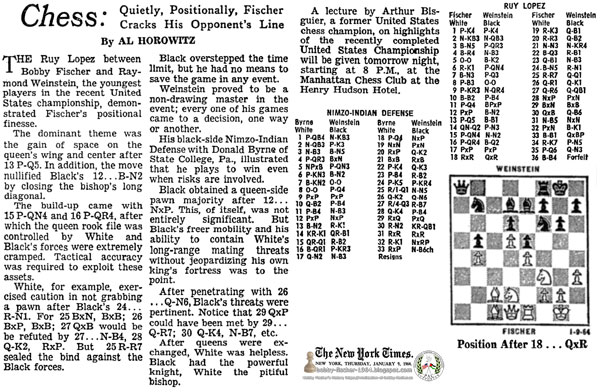New York Times, New York, New York, Thursday, January 09, 1964 - Page 28
Chess: Quietly, Positionally, Fischer Cracks His Opponent's Line
The Ruy Lopez between Bobby Fischer and Raymond Weinstein, the youngest players in the recent United States championship, demonstrated Fischer's positional finesse.
The dominant theme was the gain of space on the queen's wing and center after 13 P-Q5. In addition, the move nullified Black's 12…B-N2 by closing the bishop's long diagonal.
The build-up came with 15 P-QN4 and 16 P-QR4, after which the queen rook file was controlled by White and Black's forces were extremely cramped. Tactical accuracy was required to exploit these assets.
White, for example, exercised caution in not grabbing a pawn after Black's 24…R-N1. For 25 BxN, BxB; 26 BxP, BxB; 27 QxB would be refuted by 27… N-B4, 28 Q-K2, RxP. But 25 R-R7 sealed the bind against the Black forces.
Black overstepped the time limit, but he had no means to save the game in any event.
Weinstein proved to be a non-drawing master in the event; every one of his games came to a decision, one way or another.
His black-side Nimzo-Indian Defense with Donald Byrne of State College, Pa., illustrated that he plays to win even when risks are involved.
Black obtained a queen-side pawn majority after 12… NxP. This, of itself, was not entirely significant. But Black's freer mobility and his ability to contain White's long-range mating threats without jeopardizing his own king's fortress was to the point.
After penetrating with 26…Q-N6, Black's threats were pertinent. Notice that 29 QxP could have been met by 29… Q-R7; 30 Q-K4, N-B7, etc.
After queens were exchanged, White was helpless. Black had the powerful knight, White the pitiful bishop.























